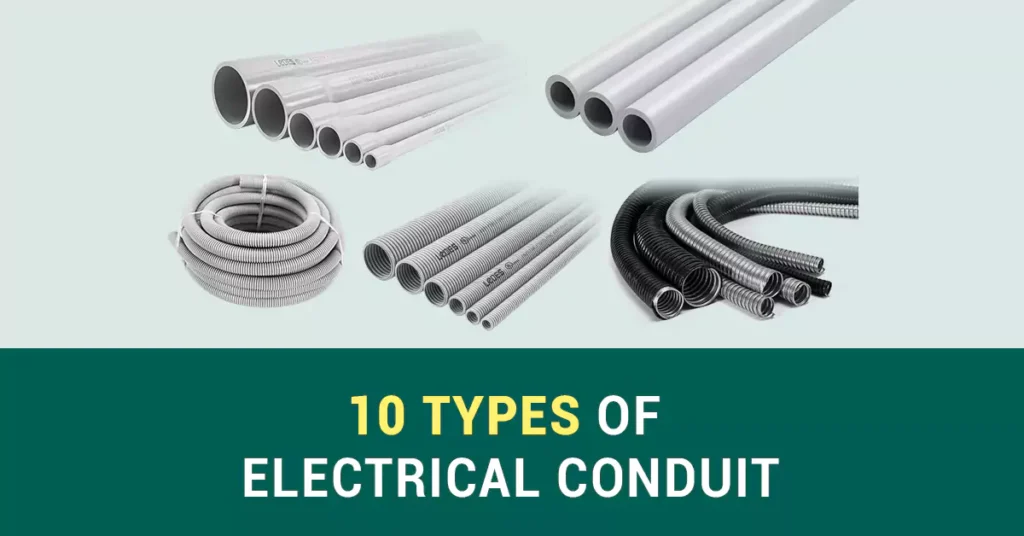
Tabla de contenido
En esta guía completa, exploraremos los 10 tipos diferentes de conductos eléctricos, sus ventajas y desventajas, y los 10 mejores consejos sobre conductos eléctricos de PVC antes de comprarlos. Comencemos.
Un conducto eléctrico es un sistema de tuberías, tubos o canales que se utiliza para proteger y enrutar cables eléctricos en edificios, viviendas y entornos industriales. Cumple varias funciones fundamentales:
- Protección: Los conductos brindan protección física para cableado eléctrico, cables y conductores, protegiéndolos de daños causados por impactos, humedad, productos químicos y otros factores ambientales. Ayudan a prevenir el contacto accidental con cables con corriente, lo que reduce el riesgo de descargas eléctricas y peligros de incendio.
- Enrutamiento y organización: Los conductos ayudan a organizar y enrutar cables y alambres eléctricos de manera estructurada. Permiten una instalación ordenada y prolija, lo que facilita la identificación y el seguimiento de circuitos o cables específicos al solucionar problemas o realizar cambios.
- Toma de tierra: Los sistemas de conductos pueden servir como una vía de conexión a tierra eficaz para equipos y circuitos eléctricos. Al conectar conductos metálicos a sistemas de conexión a tierra, se ayuda a disipar fallas eléctricas y se proporciona una medida de seguridad adicional contra fallas eléctricas y sobretensiones.
- Flexibilidad futura: Las instalaciones de conductos ofrecen flexibilidad a futuro al permitir una fácil modificación, expansión o reemplazo de cableado y cables eléctricos. Simplifica el proceso de agregar o actualizar sistemas eléctricos, lo que reduce la necesidad de realizar modificaciones extensas y minimiza las interrupciones en la infraestructura existente.
Existen muchos tipos de conductos eléctricos, cada uno con sus propias características y aplicaciones. A continuación, se indican 10 tipos comunes de conductos eléctricos:
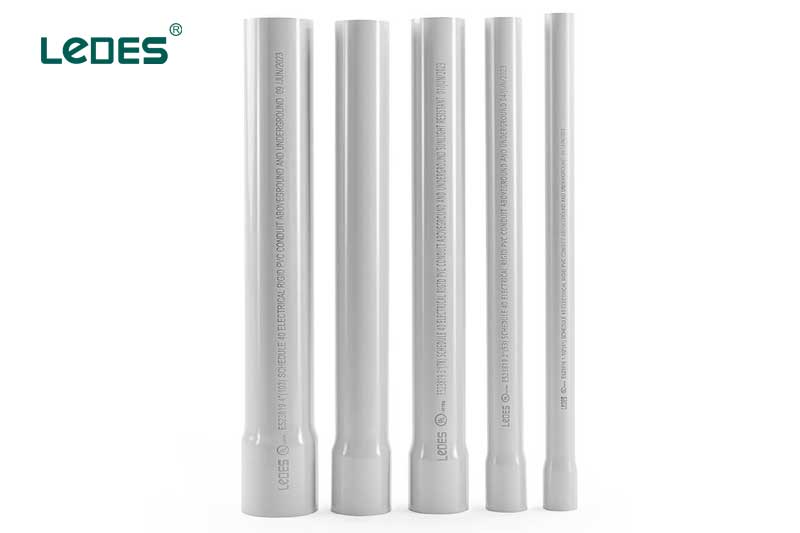
Conducto de PVC rígidoEl conducto de PVC, también conocido como tubería de PVC, es una opción popular para instalaciones de cableado eléctrico. Está hecho de un material termoplástico duradero, cloruro de polivinilo (PVC), que ofrece una excelente resistencia a la humedad, los productos químicos y la corrosión. El conducto de PVC rígido está disponible en varios tamaños y es conocido por su estructura rígida, que brinda una protección robusta para los cables eléctricos.
Estructura rígida para mayor protección.
Excelente resistencia a la humedad, productos químicos y corrosión.
Ligero y fácil de manejar.
No conductor, lo que lo hace seguro para aplicaciones eléctricas.
Interior liso para facilitar el paso del cable.
Rentable en comparación con las opciones de conductos metálicos.
Adecuado tanto para instalaciones sobre el suelo como subterráneas.
Resistente a la luz solar y a los rayos UV.
Puede soportar una amplia gama de temperaturas.
Ideal para aplicaciones residenciales, comerciales e industriales.
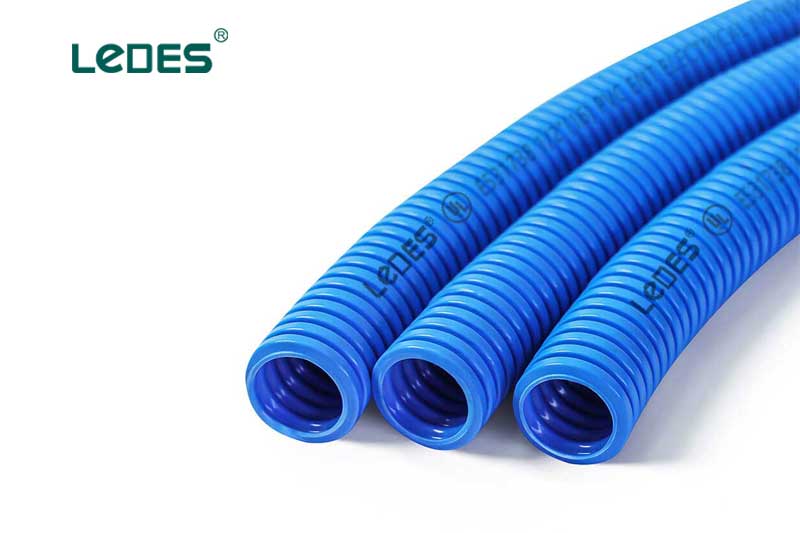
Conducto de otorrinolaringología Es un conducto de plástico corrugado flexible que es fácil de manipular e instalar. Se utiliza comúnmente en aplicaciones tanto interiores como exteriores donde se requiere flexibilidad, ya que se puede doblar a mano en el campo sin necesidad de herramientas especiales y proporciona una buena protección contra la humedad. El conducto ENT se utiliza a menudo en cableado residencial, incluidas instalaciones detrás de paredes y en losas de hormigón.
Flexible y fácil de doblar.
Exterior corrugado para mayor resistencia.
Interior suave para tirar del cable sin esfuerzo.
Propiedades ignífugas para mayor seguridad.
Ligero y fácil de manejar.
Resistente a la humedad y la corrosión.
Adecuado para aplicaciones tanto interiores como exteriores.
Ideal para instalaciones ocultas y expuestas.
Compatible con una amplia gama de cajas y accesorios eléctricos.
Menor resistencia al impacto en comparación con los conductos rígidos.
Puede requerir soporte adicional en instalaciones horizontales.
Rango de temperatura limitado en comparación con otros tipos de conductos.
El LFNC es un tipo de conducto diseñado para ser resistente al agua y al polvo. Cuenta con una cubierta exterior hermética que brinda resistencia a la humedad, los aceites y otros líquidos no peligrosos. El LFNC se utiliza con frecuencia en lugares exteriores y húmedos donde es necesaria la protección contra la exposición a la humedad o el ingreso de líquidos.
Flexible y fácil de doblar.
Resistente a la humedad, aceite y productos químicos.
Adecuado para lugares húmedos.
Proporciona alivio de tensión para los cables.
Ideal para aplicaciones exteriores y subterráneas.
Resistente a la corrosión y al óxido.
Fácil de instalar y modificar.
Se puede utilizar en zonas con exposición a productos químicos.
Adecuado para uso con accesorios herméticos.
Los conductos de polietileno de alta densidad (HDPE) son una opción duradera y versátil para instalaciones de cableado eléctrico. Los conductos de HDPE están hechos de polietileno de alta densidad, un termoplástico conocido por su excelente resistencia, resistencia al impacto y resistencia química.
Alta resistencia y resistencia al impacto.
Ligero y flexible.
Resistente a productos químicos, humedad y radiación UV.
Excelente rendimiento a largo plazo.
Adecuado tanto para instalaciones sobre el suelo como subterráneas.
Se puede utilizar en diversas condiciones ambientales.
Resistente a la corrosión y a la abrasión.
Puede soportar una amplia gama de temperaturas.
Ideal para aplicaciones exteriores e industriales.
Requiere herramientas especializadas para cortar y unir.
Costo más alto en comparación con otros tipos de conductos.
Menos rígido que los conductos de PVC o metal.
Los conductos metálicos son más resistentes, duraderos y resistentes al fuego que los conductos no metálicos. Se utilizan a menudo en entornos industriales, comerciales y peligrosos.
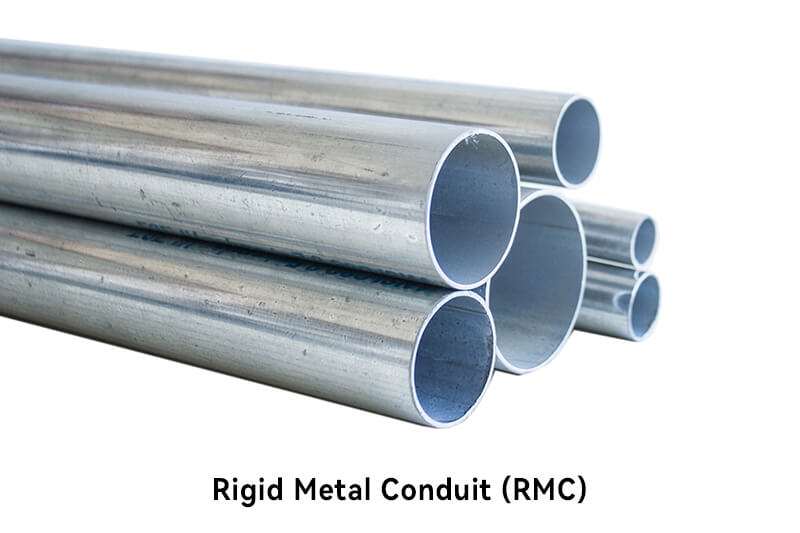
El RMC es un conducto de alta resistencia fabricado en acero galvanizado o acero inoxidable y roscado para su montaje. Proporciona una excelente protección mecánica y es adecuado tanto para aplicaciones interiores como exteriores. El RMC se utiliza habitualmente en entornos industriales y comerciales donde existe riesgo de daños físicos y se requieren altos niveles de protección.
Construcción robusta y rígida.
Excelente protección mecánica para cables.
Alta resistencia al impacto y daños físicos.
Proporciona una ruta de conexión a tierra para sistemas eléctricos.
Adecuado para ubicaciones peligrosas.
Ofrece la máxima protección contra el estrés mecánico.
Resistente al fuego, al calor y a la corrosión.
Ideal para instalaciones industriales y comerciales.
Proporciona blindaje electromagnético.
Se puede utilizar en aplicaciones expuestas u ocultas.
Más pesado y más difícil de manipular en comparación con otros tipos de conductos.
Requiere herramientas especializadas para cortar y doblar.
Mayor coste en comparación con los conductos no metálicos.
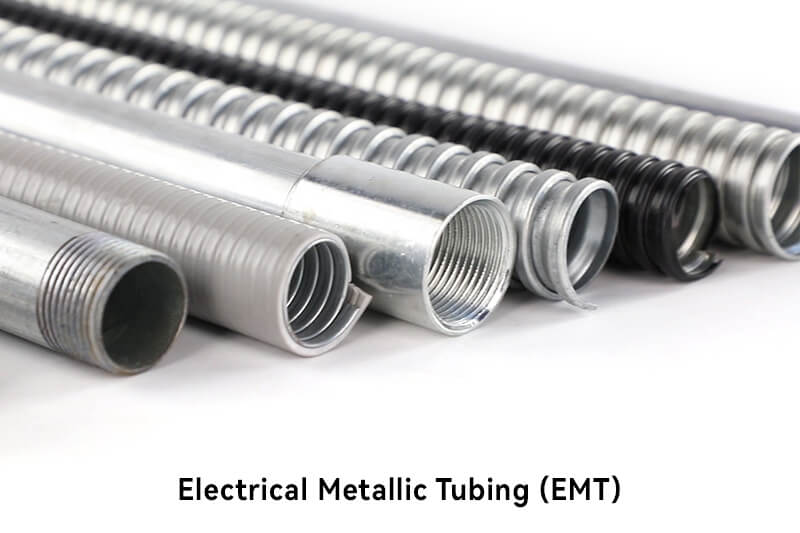
El EMT es un conducto liviano de paredes delgadas hecho de acero galvanizado o aluminio. Es más fácil de doblar e instalar que el RMC y se usa a menudo en aplicaciones residenciales y comerciales ligeras. Se usa comúnmente para cableado interior expuesto en lugares secos y húmedos.
Ligero y fácil de manejar.
Paredes delgadas para un uso eficiente del espacio.
Interior liso para facilitar el paso del cable.
Proporciona una ruta de conexión a tierra para sistemas eléctricos.
Fácil de cortar, doblar e instalar.
Rentable en comparación con otros conductos metálicos.
Adecuado para aplicaciones expuestas y ocultas.
Ideal para instalaciones residenciales y comerciales ligeras.
Compatible con una amplia gama de accesorios y herrajes.
Ofrece buena protección contra daños físicos.
Menos resistente al impacto en comparación con el conducto metálico rígido.
Idoneidad limitada para entornos con alta humedad o corrosión.
No recomendado para ubicaciones peligrosas.
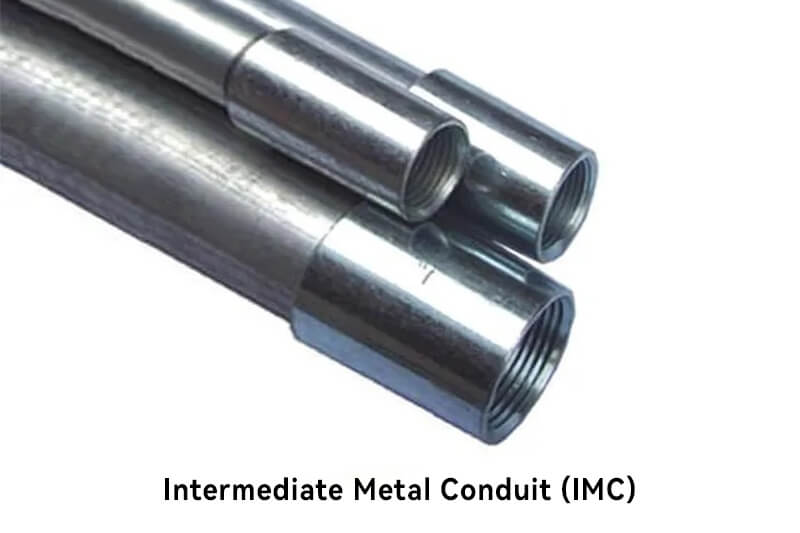
El conducto metálico intermedio, conocido como IMC, es una opción versátil de conducto metálico que ofrece un equilibrio entre la resistencia del conducto metálico rígido y la flexibilidad de los tubos metálicos eléctricos. Está fabricado con acero galvanizado y es adecuado para diversas aplicaciones de cableado eléctrico.
Construcción fuerte y rígida.
Paredes más gruesas en comparación con EMT para mayor protección.
Resistente a la corrosión gracias al revestimiento galvanizado.
Fácil de cortar, enhebrar y doblar.
Proporciona una ruta de conexión a tierra para sistemas eléctricos.
Ofrece protección mecánica mejorada para cables eléctricos.
Resistente al fuego, al calor y a la corrosión.
Adecuado para aplicaciones tanto interiores como exteriores.
Compatible con accesorios y conectores estándar.
Proporciona blindaje electromagnético.
Más pesado y más difícil de manejar en comparación con EMT.
Requiere herramientas especializadas para cortar y doblar.
Mayor coste en comparación con EMT.
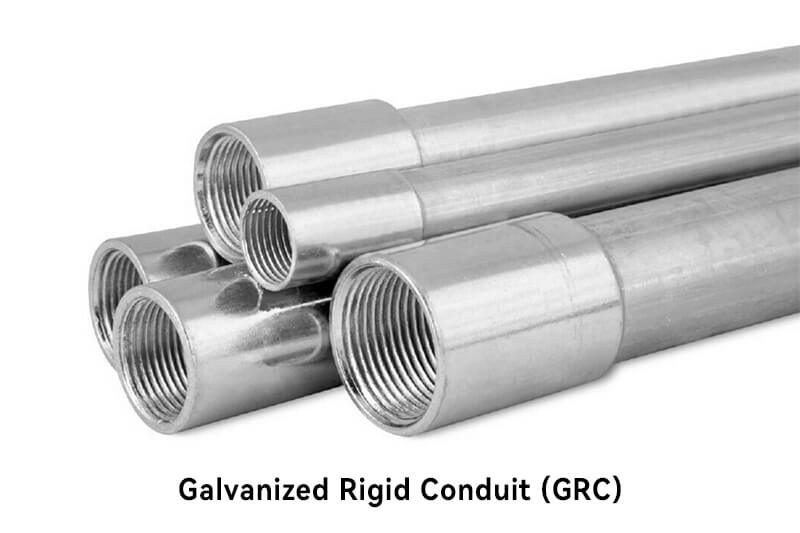
El GRC es el tipo de conducto metálico más pesado y duradero fabricado con acero galvanizado. Ofrece una protección mecánica superior, lo que lo hace ideal para entornos hostiles. El GRC se utiliza comúnmente en aplicaciones industriales, instalaciones al aire libre y en entornos peligrosos donde existe riesgo de incendio o explosión.
Construcción robusta y rígida.
Recubierto de zinc para resistencia a la corrosión.
Excelente protección mecánica para alambres y cables.
Proporciona una ruta de conexión a tierra para sistemas eléctricos.
Adecuado para ubicaciones peligrosas.
Ofrece la máxima protección contra el estrés mecánico y la corrosión.
Resistente al fuego, al calor y a la humedad.
Ideal para aplicaciones exteriores y subterráneas.
Proporciona blindaje electromagnético.
Compatible con accesorios y conectores estándar.
Más pesado y más difícil de manipular en comparación con otros tipos de conductos.
Requiere herramientas especializadas para cortar y doblar.
Mayor coste en comparación con los conductos no metálicos.
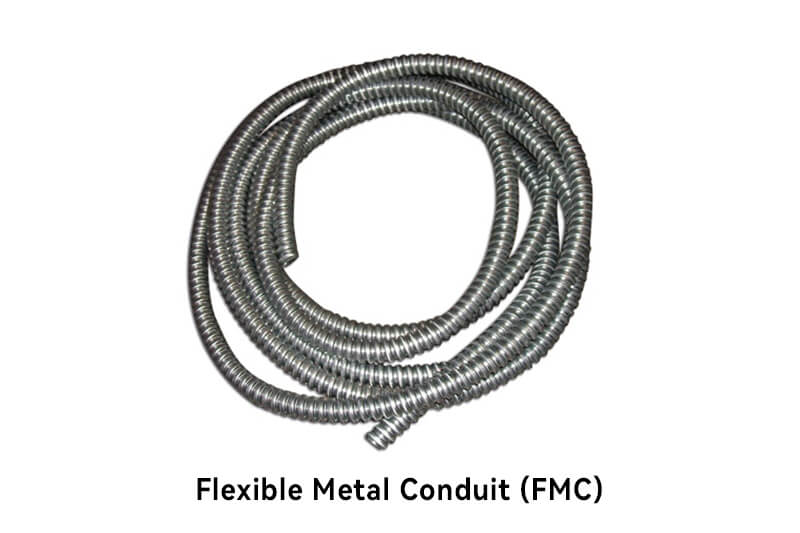
El FMC, también conocido como “Greenfield”, es un conducto flexible hecho de tiras de metal enrolladas en espiral, generalmente de acero galvanizado o aluminio. Proporciona una buena flexibilidad para enrutar cables en espacios reducidos o curvos. El FMC se utiliza comúnmente en aplicaciones expuestas en interiores donde se requiere flexibilidad.
Flexible y fácil de doblar.
Exterior corrugado para mayor resistencia.
Interior liso para facilitar el paso del cable.
Proporciona una ruta de conexión a tierra para sistemas eléctricos.
Resistente al impacto y daños físicos.
Ofrece flexibilidad para enrutar cables a través de espacios complejos.
Adecuado tanto para instalaciones expuestas como ocultas.
Compatible con accesorios y conectores estándar.
Fácil de cortar, doblar e instalar.
Proporciona una buena protección contra el estrés mecánico.
Menos rígido en comparación con el conducto metálico rígido.
Idoneidad limitada para zonas con alta humedad o ambientes corrosivos.
No recomendado para ubicaciones peligrosas.
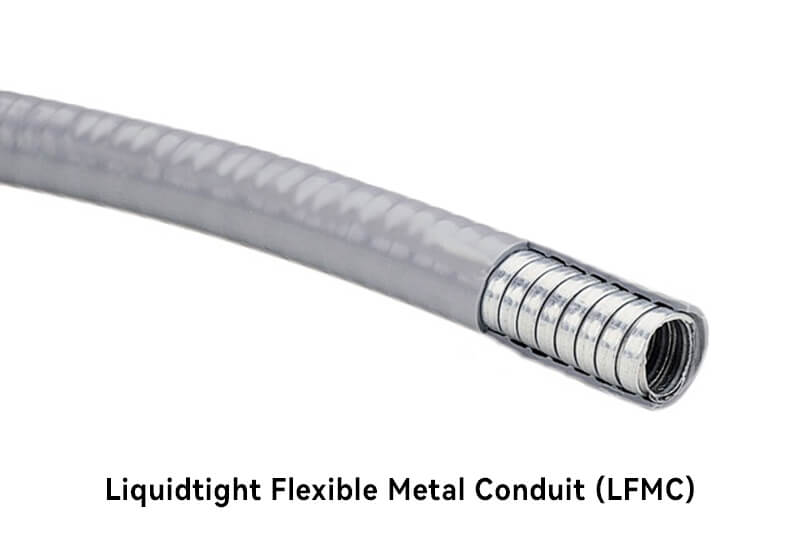
El LFMC cuenta con una cubierta exterior hermética que brinda protección contra el agua, los aceites y otros líquidos. Es un tipo de FMC que está diseñado para ser resistente al agua y al polvo. Se utiliza comúnmente en lugares al aire libre y húmedos, como iluminación exterior o áreas expuestas a la humedad.
Flexible y fácil de doblar.
Exterior corrugado para mayor resistencia.
Chaqueta estanca para protección contra líquidos.
Proporciona una ruta de conexión a tierra para sistemas eléctricos.
Resistente al impacto y daños físicos.
Ideal para exteriores y lugares húmedos.
Resistente a la humedad, aceites y productos químicos.
Proporciona alivio de tensión para los cables.
Adecuado para uso con accesorios herméticos.
Compatible con accesorios y conectores estándar.
Rango de temperatura limitado en comparación con otros tipos de conductos.
Puede requerir soporte adicional en instalaciones horizontales.
No apto para aplicaciones de alto impacto o de trabajo pesado.
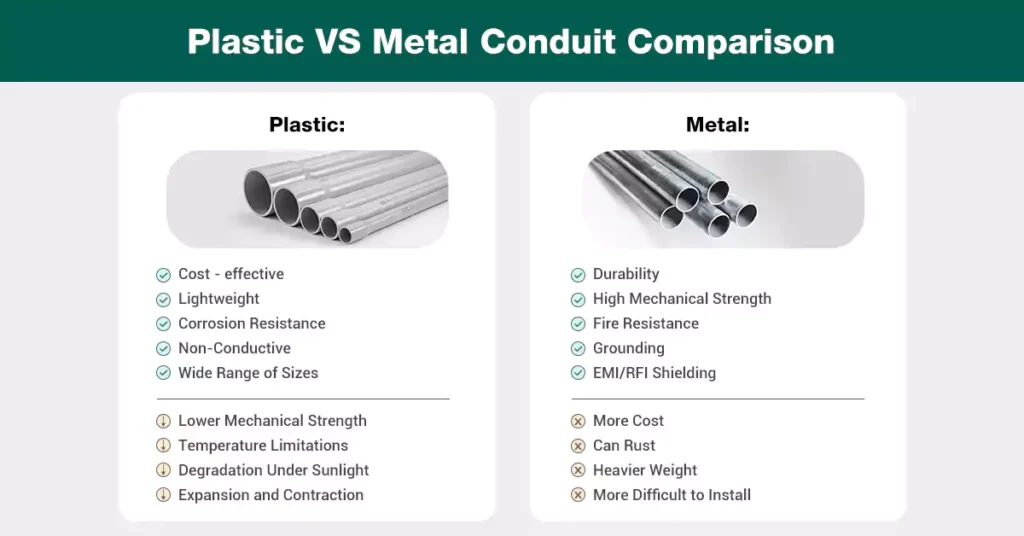
- Costo: Los conductos de plástico, como el PVC (cloruro de polivinilo) o el HDPE (polietileno de alta densidad), generalmente son más rentables que las opciones de conductos de metal.
- Ligero: Los conductos de plástico son livianos, lo que hace que sea más fácil manipularlos e instalarlos, especialmente en situaciones de cableado aéreo o de rutas complejas.
- Resistencia a la corrosión: A diferencia de los conductos de metal, los conductos de plástico no son susceptibles a la corrosión, lo que los hace adecuados para áreas con alta humedad, productos químicos o sustancias corrosivas.
- No conductor: Los conductos de plástico no son conductores, lo que elimina la necesidad de conexión a tierra en la mayoría de las aplicaciones.
- Amplia gama de tamaños: Los conductos de plástico están disponibles en varios tamaños, lo que permite flexibilidad para adaptarse a diferentes diámetros de cables o alambres.
Resistencia mecánica: Los conductos de plástico tienen una resistencia mecánica menor que sus contrapartes de metal. Es posible que no brinden tanta protección física al cableado, especialmente en áreas propensas a impactos o estrés mecánico.
Limitaciones de temperatura: Los conductos de plástico tienen limitaciones de temperatura y pueden no ser adecuados para entornos de alta temperatura o aplicaciones donde se requiere resistencia al fuego.
Resistencia a los rayos UV: Algunos tipos de conductos de plástico pueden degradarse con el tiempo cuando se exponen a la radiación UV, por lo que pueden requerir protección UV adicional si se utilizan al aire libre.
Expansión y contracción: Los conductos de plástico pueden expandirse y contraerse con los cambios de temperatura, lo que puede requerir tolerancias adecuadas durante la instalación.
- Durabilidad y resistencia mecánica: Los conductos metálicos, como RMC, IMC o EMT, ofrecen protección mecánica y durabilidad superiores, lo que los hace ideales para aplicaciones que requieren un blindaje físico robusto para el cableado.
- Resistencia al fuego: Los conductos metálicos suelen tener mejores propiedades de resistencia al fuego en comparación con los conductos de plástico, lo que los hace adecuados para instalaciones donde la seguridad contra incendios es una preocupación.
- Toma de tierra: Los conductos metálicos proporcionan una ruta de conexión a tierra para los sistemas eléctricos, lo que garantiza la seguridad eléctrica adecuada y el cumplimiento de los requisitos de conexión a tierra.
- Blindaje EMI/RFI: Los conductos metálicos proporcionan protección contra interferencias electromagnéticas (EMI) e interferencias de radiofrecuencia (RFI), lo que resulta beneficioso en entornos con equipos electrónicos sensibles y para reducir el ruido eléctrico.
- Cumplimiento de los códigos: En algunas áreas, los códigos eléctricos locales pueden requerir el uso de tipos específicos de conductos metálicos para ciertas aplicaciones.
Costo: Los conductos metálicos, especialmente las opciones rígidas, tienden a ser más caros que los conductos de plástico.
Complejidad de instalación: los conductos de metal pueden requerir herramientas especializadas, como dobladoras y roscadoras de conductos, para cortarlos, doblarlos e instalarlos. También pueden requerir una instalación que requiera más mano de obra en comparación con los conductos de plástico.
Corrosión: Si bien los conductos de metal generalmente están recubiertos o galvanizados para resistir la corrosión, pueden ser susceptibles a la oxidación y la degradación con el tiempo, especialmente en entornos corrosivos. Se deben considerar medidas adecuadas de protección contra la corrosión.
Peso: Los conductos de metal son más pesados que los de plástico, lo que puede dificultar su manipulación e instalación, especialmente en aplicaciones aéreas o de largo recorrido.
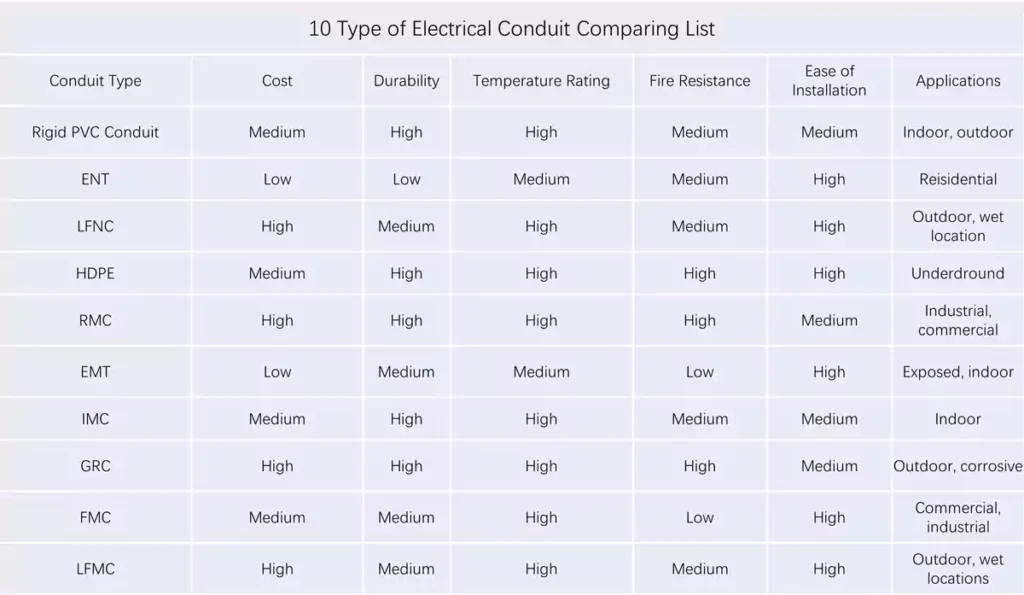
Lista comparativa de 10 tipos de conductos eléctricos
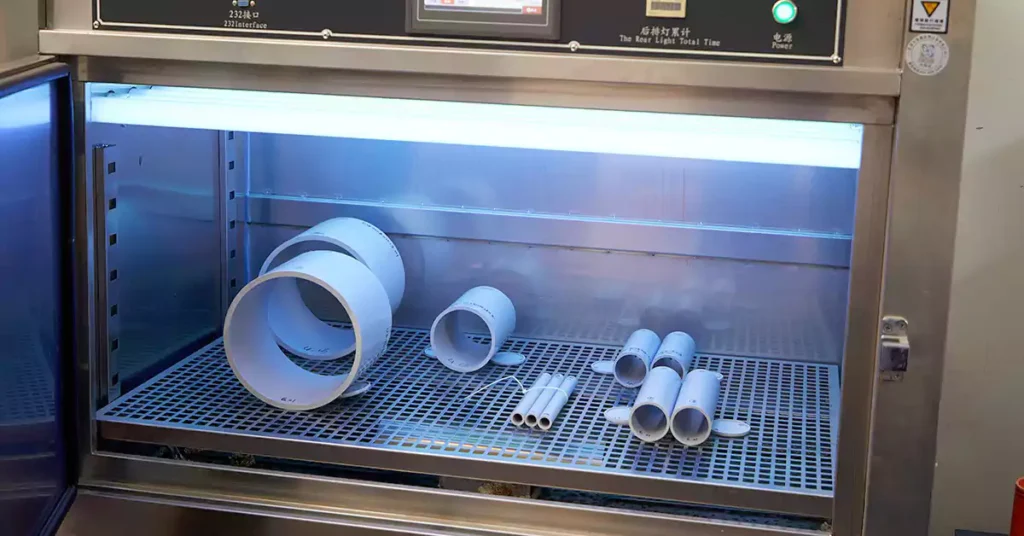
En instalaciones eléctricas exteriores, seleccionar el conducto adecuado es crucial para garantizar la protección y la longevidad del sistema de cableado. Los entornos exteriores presentan desafíos únicos, como la exposición a la intemperie, la radiación UV, las variaciones de temperatura y la posible tensión mecánica. A continuación, se presentan algunas opciones de conductos adecuados para aplicaciones exteriores, junto con materiales resistentes a la intemperie y accesorios adecuados:
Conducto metálico rígido (RMC): Proporciona una excelente protección mecánica y durabilidad, lo que lo hace adecuado para instalaciones en exteriores.
Conducto metálico intermedio (IMC): El IMC es otra opción para uso en exteriores, ya que ofrece un equilibrio entre rigidez y flexibilidad. El IMC es adecuado para aplicaciones en exteriores donde se requiere una protección mecánica moderada, como instalaciones de iluminación exterior o conductos subterráneos.
Conducto de PVC: El conducto de PVC (cloruro de polivinilo) es una opción común para aplicaciones al aire libre debido a su asequibilidad, resistencia a la corrosión y facilidad de instalación.
Los conductos de PVC están disponibles en diferentes calibres, siendo el calibre 40 el más común para uso en exteriores.
Conducto de HDPE: Conocido por su excepcional durabilidad y resistencia a impactos, productos químicos y radiación ultravioleta, se utiliza comúnmente para instalaciones subterráneas o enterradas directamente en ambientes exteriores.
Al instalar conductos en exteriores, es fundamental utilizar accesorios y conectores resistentes a la intemperie adecuados que proporcionen un sellado seguro y hermético. Estos accesorios pueden incluir acoplamientos resistentes a la intemperie, conectores herméticos a la lluvia, juntas o accesorios de compresión diseñados para uso en exteriores. Además, se deben emplear técnicas de sellado adecuadas, como el uso de selladores o cintas adecuados, para evitar la entrada de agua.
Los conductos son un componente esencial en las instalaciones eléctricas, ya que brindan protección, organización y seguridad al cableado eléctrico. Consisten en tuberías, tubos o canales que encierran y protegen los conductores eléctricos, lo que garantiza que estén protegidos contra daños físicos, humedad, productos químicos y otros factores externos. A continuación, se explica por qué y cuándo son necesarios los conductos:
Protección: Los conductos actúan como barrera protectora para el cableado eléctrico, protegiéndolo de daños accidentales, impactos y exposición a entornos hostiles. Ayudan a prevenir riesgos como cortocircuitos, incendios eléctricos y electrocución.
Organización: El conducto permite un enrutamiento ordenado y organizado de cables eléctricos, lo que facilita su identificación, mantenimiento y futuras modificaciones o actualizaciones.
Seguridad: Al encerrar los conductores eléctricos, los conductos reducen el riesgo de contacto accidental, especialmente en áreas donde el cableado está expuesto o es accesible a personas o equipos.
Cumplimiento: La instalación de conductos suele ser requerida por los códigos y regulaciones eléctricas locales para cumplir con los estándares de seguridad y garantizar prácticas de instalación adecuadas.
Flexibilidad: Los conductos brindan flexibilidad en términos de futuras ampliaciones o cambios en el sistema eléctrico. Permiten agregar o quitar cables sin necesidad de realizar modificaciones o interrupciones importantes.
Edificios comerciales e industriales: Los códigos locales generalmente exigen el uso de conductos en edificios comerciales e industriales para cumplir con los requisitos de seguridad y facilitar el mantenimiento y las modificaciones.
Instalaciones exteriores: Cuando el cableado eléctrico está expuesto a elementos exteriores, a menudo se requieren conductos para protegerlo de la humedad, la radiación ultravioleta, las variaciones de temperatura y los daños físicos. Esto incluye aplicaciones como iluminación exterior, sistemas de riego o conductos subterráneos.
Ubicaciones peligrosas: Los conductos son necesarios en lugares peligrosos donde hay gases, vapores o polvos combustibles inflamables. Ayudan a contener posibles chispas o fallas eléctricas, lo que reduce el riesgo de ignición y explosiones.
Áreas propensas a estrés mecánico: Los conductos son necesarios en áreas donde existe una alta probabilidad de estrés mecánico, como sitios de construcción, instalaciones industriales o áreas con maquinaria pesada. Proporcionan protección adicional contra impactos accidentales, vibraciones o aplastamientos.
Espacios públicos: En espacios públicos como escuelas, hospitales o edificios gubernamentales, a menudo se requieren conductos para mejorar la seguridad eléctrica, evitar manipulaciones y facilitar un mantenimiento eficiente.
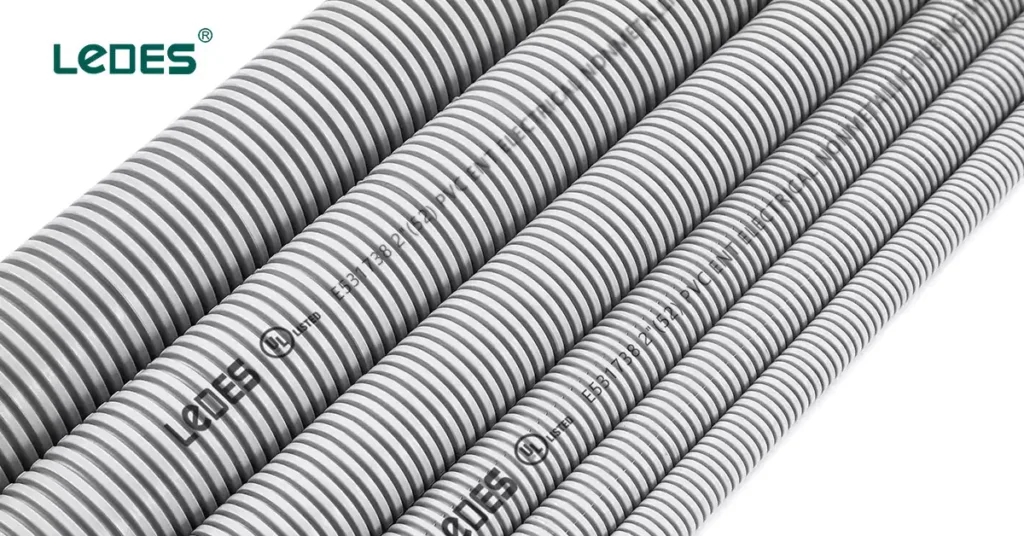
Seleccionar el conducto adecuado para su instalación eléctrica es fundamental para garantizar la seguridad, el cumplimiento normativo y la funcionalidad. A continuación, se incluye una guía sobre cómo elegir el conducto adecuado, teniendo en cuenta diversos factores:
- Material:
Evalúe las opciones de materiales disponibles para los conductos, como PVC, metal (por ejemplo, acero o aluminio) o conductos flexibles (por ejemplo, herméticos o corrugados). Considere las propiedades específicas de cada material, como la durabilidad, la resistencia a la corrosión y la idoneidad para la aplicación prevista.
- Factores ambientales:
Evaluar las condiciones ambientales donde se instalará el conducto, como exposición a humedad, productos químicos, temperaturas extremas o estrés mecánico.
Elija un material de conducto que pueda soportar estas condiciones. Por ejemplo, los conductos de PVC son resistentes a la humedad y la corrosión, mientras que los conductos metálicos ofrecen una mejor protección contra el estrés mecánico.
- Resistencia mecánica:
Determine la resistencia mecánica requerida en función de la aplicación. Considere factores como la resistencia al impacto, la capacidad de carga, la resistencia a la presión y la capacidad para soportar vibraciones o fuerzas externas.
- Ubicación de instalación:
Tenga en cuenta la ubicación específica de la instalación del conducto, ya sea en interiores, exteriores, bajo tierra o expuesto.
Diferentes ubicaciones pueden requerir distintos tipos de conductos. Para instalaciones exteriores o subterráneas, es posible que necesite conductos con mayor durabilidad y resistencia a la intemperie.
- Resistencia a productos químicos:
Evalúe si el conducto estará expuesto a sustancias químicas o corrosivas. Elija un material de conducto que ofrezca la resistencia adecuada a estas sustancias para garantizar un rendimiento y una seguridad a largo plazo.
- Certificaciones:
Busque conductos que cumplan con los estándares de la industria y las certificaciones pertinentes a su aplicación. Algunos ejemplos incluyen las certificaciones UL (Underwriters Laboratories) para seguridad eléctrica en los EE. UU. o las certificaciones CSA para conductos en Canadá y las certificaciones AS/NZS en Australia. Conozca los códigos y las regulaciones locales para conductos eléctricos y elija a aquellos proveedores que ya hayan obtenido los certificados del producto.
- Flexibilidad y modificaciones futuras:
Considere la necesidad de flexibilidad en su sistema eléctrico. ¿Necesitará realizar modificaciones, ampliaciones o actualizaciones en el futuro?
Las opciones de conductos flexibles, como los conductos metálicos flexibles herméticos a líquidos o los conductos no metálicos flexibles, brindan un acceso más fácil y permiten realizar cambios sin necesidad de realizar grandes modificaciones.
- Tamaños y dimensiones:
Determine el tamaño y las dimensiones adecuados del conducto en función de la cantidad y el tamaño de los cables o alambres que se alojarán en él. Asegúrese de que el conducto seleccionado pueda soportar la capacidad requerida.
- Marcas:
Investigue marcas confiables que ofrezcan conductos de alta calidad y tengan un historial de confiabilidad.
Tenga en cuenta factores como la reputación de la marca, las opiniones de los clientes y la disponibilidad de sus productos en su zona.
- Costo y disponibilidad:
Evaluar la relación coste-efectividad y la disponibilidad de las opciones de conductos.
Compare los costos de diferentes materiales de conductos, considerando tanto el costo inicial como los requisitos de mantenimiento a largo plazo.
Asegúrese de que el conducto elegido esté disponible en su área para evitar retrasos en el proceso de instalación.
Recuerde consultar con profesionales de la electricidad, como electricistas o ingenieros, para obtener recomendaciones específicas en función de los requisitos de su proyecto. Pueden brindar información valiosa y garantizar el cumplimiento de las normativas locales.
A continuación se presentan algunos proyectos en los que Ledes ha participado y los tipos de conductos que proporcionamos para estos proyectos.
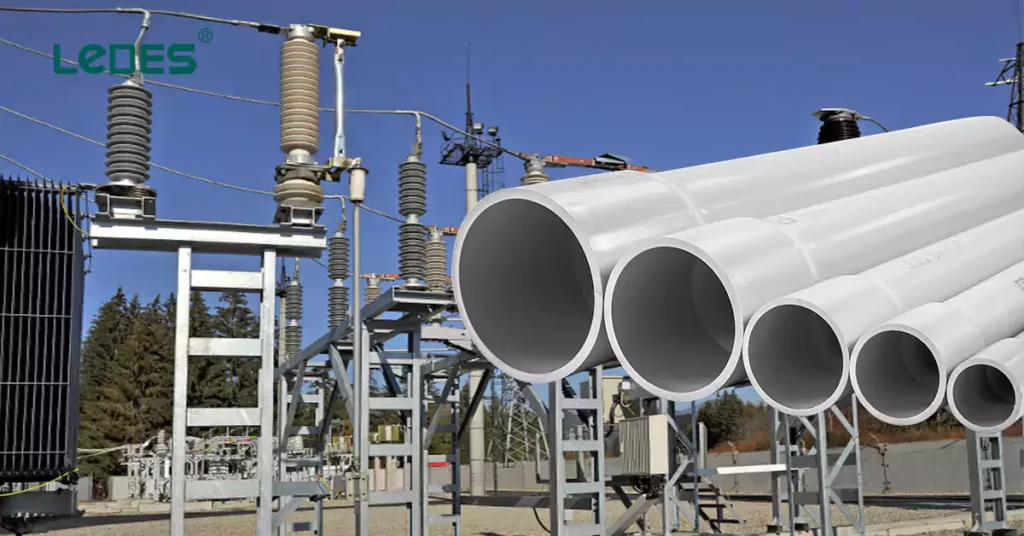
El Champlain Hudson Power Express® (CHPE) es un proyecto innovador de transmisión de energía renovable que tiene como objetivo suministrar energía limpia y confiable a Nueva York. Este proyecto de cable eléctrico submarino y subterráneo de corriente continua de alto voltaje (HVDC) conectará el área de Quebec con el barrio de Astoria en Queens, Nueva York.
El proyecto CHPE desempeña un papel importante en la transformación energética del estado al reducir las emisiones de gases de efecto invernadero y contribuir a un medio ambiente más limpio. Está diseñado para reducir la dependencia de los combustibles fósiles y promover la adopción de fuentes de energía renovables. Al proporcionar energía renovable de bajo costo a Nueva York, el proyecto no solo ayuda a satisfacer las demandas energéticas del estado, sino que también contribuye al crecimiento económico y la creación de empleo.
El proyecto CHPE ha seleccionado a Ledes Listado UL Conducto de PVC Schedule 40 como el conducto de elección para su instalación eléctrica. El conducto de PVC rígido Schedule 40 de Ledes es una opción duradera y confiable que brinda una excelente protección para el cableado eléctrico. Los conductos de PVC son resistentes a la humedad, la corrosión y diversos factores ambientales, lo que los hace adecuados para aplicaciones tanto en interiores como en exteriores. La selección del conducto de PVC rígido Schedule 40 de Ledes garantiza la seguridad y la longevidad de la infraestructura eléctrica asociada con el proyecto CHPE.
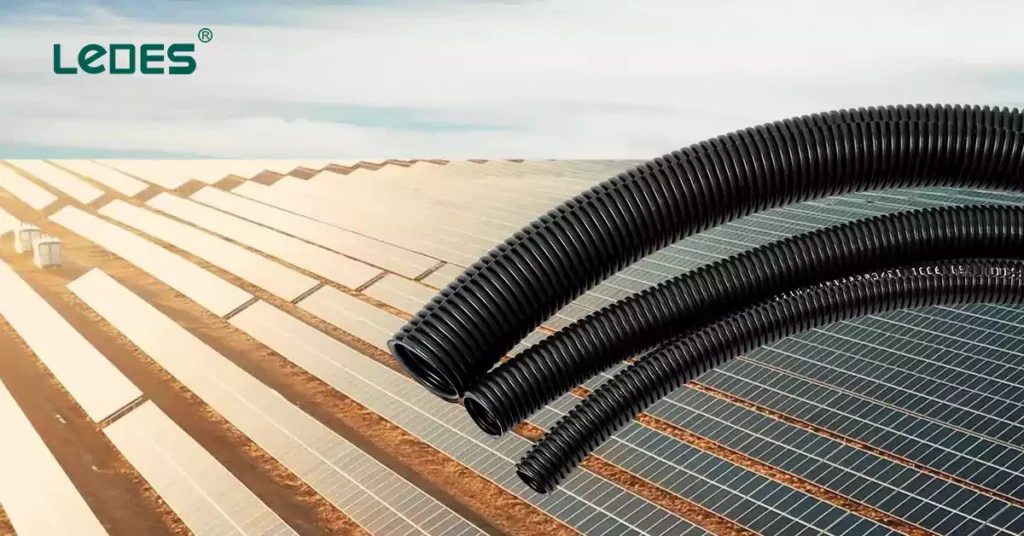
El proyecto de energía solar Al Dhafrah PV2 y el proyecto fotovoltaico de 2,6 GW en Arabia Saudita son los dos proyectos solares más grandes del mundo. Contribuyen de manera significativa a los objetivos de energía renovable del país y están comprometidos con la transición hacia fuentes de energía sostenibles. Estos dos proyectos implican el desarrollo y la implementación de una capacidad de generación de energía a gran escala de 2 GW y 2,6 gigavatios (GW) utilizando fuentes de energía renovables.
En línea con los requerimientos del proyecto, Ledes Conductos corrugados serie solar Se han elegido como solución de conductos los conductos de la serie solar de Ledes que ofrecen una protección fiable para la infraestructura eléctrica asociada a los proyectos de energía solar y eólica. Están diseñados para soportar las exigentes condiciones ambientales que se dan en las instalaciones de energía renovable, garantizando la seguridad y la longevidad del cableado eléctrico.
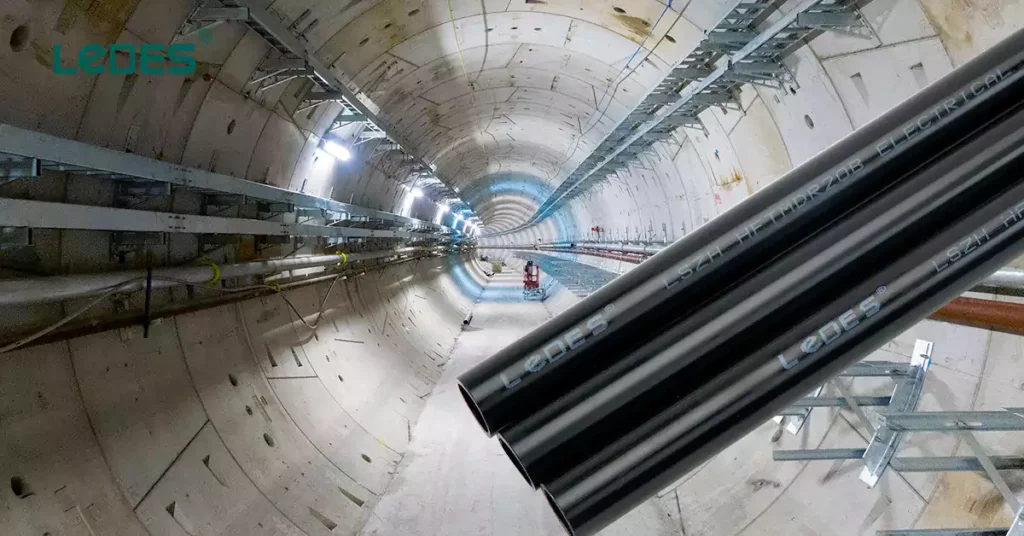
El proyecto del Metro Rail de Melbourne es uno de los proyectos de infraestructura más grandes y complejos de Australia. El Metro Tunnel incluye la construcción de dos túneles ferroviarios gemelos de 9 kilómetros con cinco nuevas estaciones subterráneas. Este proyecto subterráneo incluye la instalación de señalización de alta capacidad y electricidad operativa, que tiene estrictos requisitos de seguridad eléctrica y contra incendios.
Para cumplir con los requisitos de seguridad eléctrica, eligió a Ledes. Conducto libre de halógenos y baja emisión de humo y accesorios para su sistema de cableado eléctrico. Los conductos de baja emisión de humo y libres de halógenos de Ledes están aislados y brindan una mejor prevención contra accidentes por descargas eléctricas. Tienen un excelente rendimiento resistente al fuego, certificado con resistencia al fuego de clasificación V0. Y no producen humo denso ni humo tóxico durante el incendio. Proporcionan protección adicional para el sistema eléctrico y el personal.
En conclusión, seleccionar el conducto eléctrico adecuado es crucial para garantizar la seguridad y la eficiencia del sistema de cableado. Debe comprender los diferentes tipos de conductos eléctricos disponibles y los requisitos específicos del proyecto. Además, tenga en cuenta estos factores que hemos mencionado en el artículo y sus propias necesidades específicas para decidir qué tipo de conducto elegir. Recuerde priorizar la seguridad, la durabilidad y el cumplimiento de las normativas locales.
Si no está seguro de qué tipo de conducto eléctrico elegir para su aplicación, El equipo profesional de LEDES puede ayudarle a proporcionar la mejor solución eléctrica para usted.



